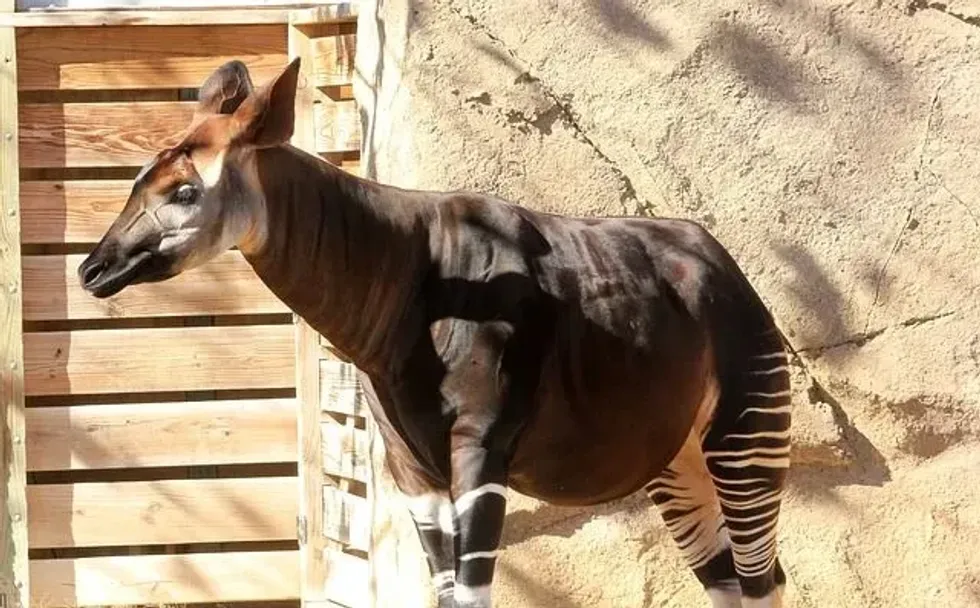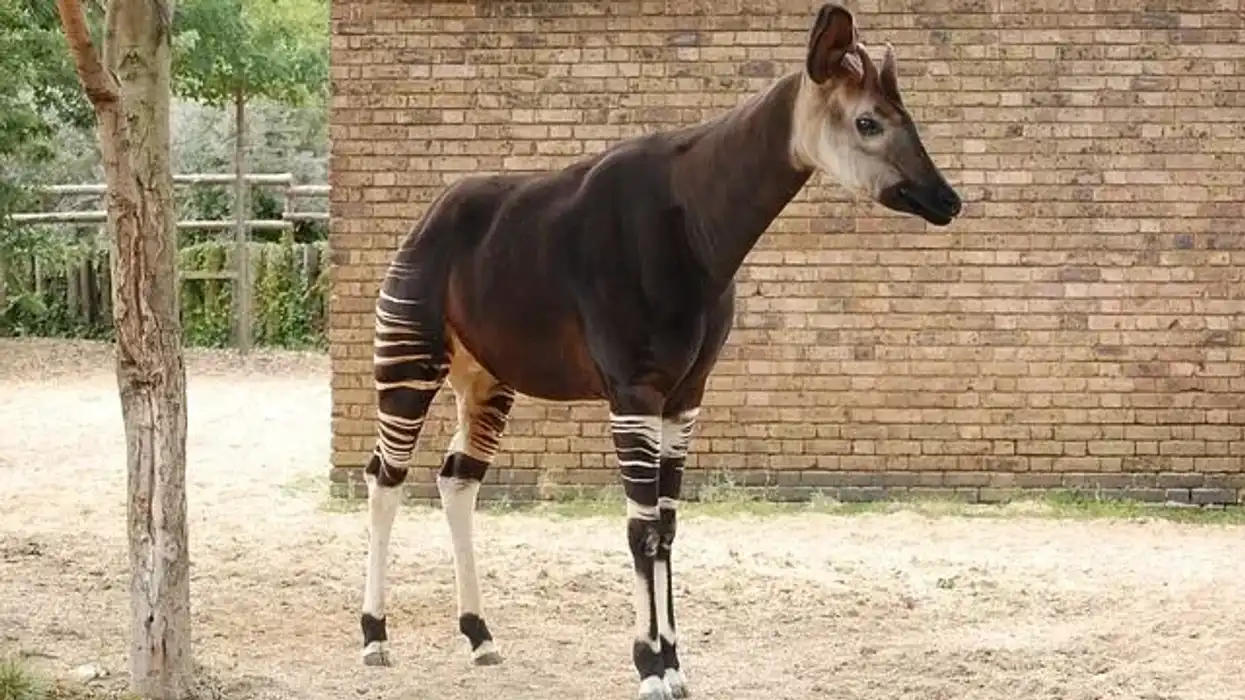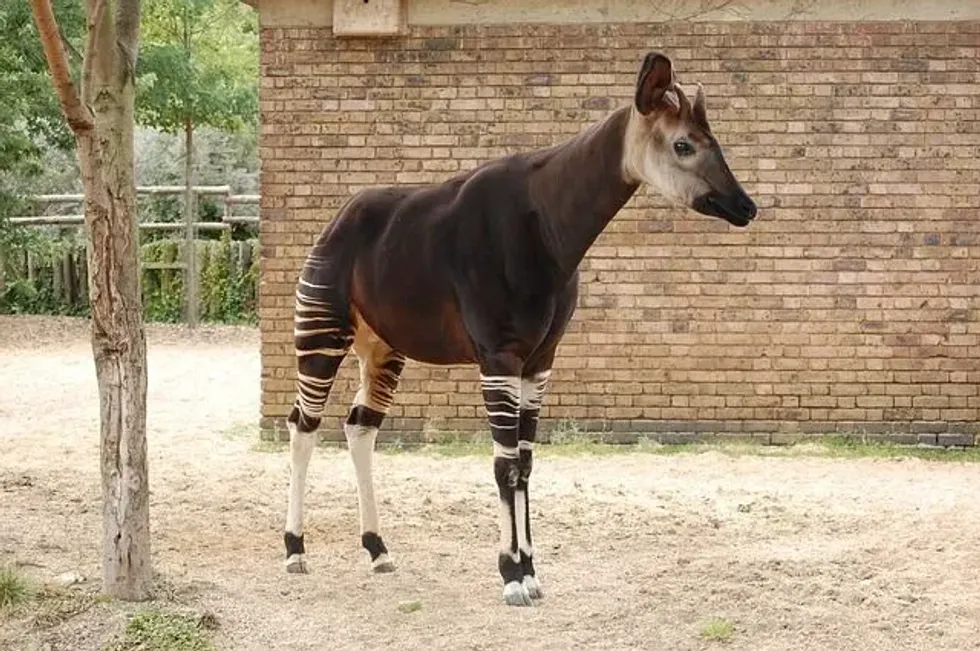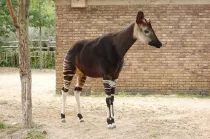Fun Okapi Facts For Kids

The natives of the Ituri Rainforest of Congo, Okapis (scientific name Okapia johnstoni) are giraffe-like mammals not found in other parts of the world. With stripes of black and white, okapis also look like zebras. They are also called Forest Giraffes.
Surprisingly these mammals were unheard of till the start of the 20th century when Sir Henry Morgan Stanley first found them. They have shorter necks and legs than the giraffe and also are a rare species.
These are herbivores with diets composed of plants, fruits, ferns, and grasses. Okapi males have soft horns (also called ossicones) while females do not. They sleep for only five minutes and are mostly active during the day.
They have a lifespan of about 15-20 years on average. Their lifespan increases up to 30 years in captivity.
The okapi animal is known to be shy by nature and hence it does not like to appear openly. Okapis are considered adults and able to reproduce at the age of two years. After mating, male and female Okapis generally do not live together.
Okapis have a strong sense of smell and can identify other Okapis around by barely sniffing. The main threats to these species are human settlement, hunting, predators, and habitat destruction.
Their population has decreased by 50% in the past two decades. These species are endangered, with only about 22000 okapis remaining. They are taken care of through the Okapi Conservation Project.
If you like this article, feel free to check out these fun facts on the reticulated giraffe and zorse.
Okapi Interesting Facts
What type of animal is an okapi?
The Okapi is an animal native only to the Ituri forest of Congo. It belongs to the family Giraffidae, and it is the only close relative of the giraffe. However, it mostly resembles deer and zebras due to its black white stripes. It is an ungulate, which means it has hooves on its feet.
What class of animal does an okapi belong to?
The Okapi (Okapia johnstoni) is a mammal.
How many okapis are there in the world?
Okapis are an endangered species. There are only 22000 okapis left in the world.
Where does an okapi live?
Okapis live in the Ituri Rain forest (i.e. a tropical canopy rain forest) located in the North-Eastern regions of the Democratic Republic of Congo. They are not found in any other part of the world.
What is an okapi's habitat?
The Okapi’s habitat is a tropical rainforest of the Democratic Republic of Congo.
Who do okapis live with?
Okapis are shy and do not believe in lifelong companionship. They are most likely to be found alone, barring a few exceptions. The male and female okapis only come together for reproduction, after which they again separate.
How long does an okapi live?
The highest recorded lifespan of an okapi was 33 years. However, the lifespan of the Okapi is 30 years only in captivity. The average lifespan of a wild Okapi is 15-20 years.
How do they reproduce?
Okapis are shy and reserved by nature. The males attain sexual maturity by the age of two, whereas the females achieve it when they are one and a half years old. Rut and estrous in males and females respectively is irrelevant to the season, i.e.
it can occur anytime. The male and the female Okapi communicate sexual behavior by making a peculiar sound called ‘chuffing’. Usually, Okapis make infra or low-frequency sounds that cannot be heard by the human ear.
They express interest through different body languages, which involve circling and licking each other. After this, copulation takes place. The male and female Okapis do not stay together after the purpose of reproduction is over.
The gestation period of a female Okapi is about a year and three months (approximately 440 days). Normally only one Okapi baby is born, which is called a calf.
Baby Okapis learn to walk within half an hour of birth. They are usually kept in seclusion and are fiercely protected by the mother Okapi. Due to less and infrequent feeding, the Okapi calf does not defecate.
This is done to keep the calf safe from any Okapi predators that may track down the smell of excreta. After about half a year (six months) of its birth, the Okapi calf is weaned and free to explore on its own.
What is their conservation status?
The Okapis are an endangered species. They are strongly under the vigilance and purview of Congolese law. In the Ituri forest ecosystem, it is the main species that is under conservation. The Okapi Wildlife Reserve has a considerable population of Okapis and is under strict conservation.
The other place where Okapis are conserved is Maiko National Park. Okapis are also kept in some zoos. Okapis were brought to the San Diego Zoo in 1956.
Despite all measures, the population of Okapis has decreased significantly in the past few years due to habitat destruction, logging, human settlement, and other such threats. In Uganda, there was some prior presence of Okapis (in the Semliki Forest) but according to the IUCN Red List of 2008, there are no Okapis left there now.
In 1987, the Okapi Conservation Project was established.
In 1998, the Okapi Reserve entered the list of World Heritage in Danger due to the frequent destruction of wildlife by inhabitants and invasion by humans. The IUCN, with the help of ICCN and ZSL, formulated a global strategy to save Okapis from extinction in 2016.
Okapi Fun Facts
What do okapis look like?
Okapis are a peculiar-looking species. At first sight, it would look like a cross between a deer and a zebra. Also called Forest Giraffes, their scientific name is Okapia johnstoni. They are the only living relatives of giraffes.
These shy, reserved animals live in seclusion. They are rarely ever found in groups and only come together for breeding. Okapis belong to the order Artiodactyla, which means that they have hooves on their feet. These types of animals with hooves are also called ungulates.
Okapis have a very interesting appearance. They have shiny brown coats which resemble that of a horse.
However, they have black and white stripes at the backs of their bodies and on their legs. This makes them look more like zebras. The skin of the okapi helps it adapt to its dense surroundings and provide camouflage.
The stripes on its body make it resemble the rays of sunlight coming from between the trees. It is thus, able to hide from the chief okapi predators in the wild, leopards. Adult okapis have a height of approximately 5 ft.
They are characterized by a long, study neck, large round ears, and giraffe-like broad teeth with gaps in between. Okapis have a shorter, stouter, and more rounded physique compared to the giraffe.
There is a difference in the appearance of the male and female Okapis. The males have soft horns like that of a giraffe. These are called ossicones. The females do not have ossicones, but hair whorls on their heads.

How cute are they?
Okapis are very cute. With large round ears and a harmless, timid appearance, the Okapi looks adorable. The Okapi baby is even cuter. It is a shy, docile and peaceful mammal, but very hard to spot!
How do they communicate?
Okapis are usually very silent. But, according to research conducted by the San Diego Zoo Wildlife Alliance Conservation, Okapis communicate through chuffing, bleats and whistles.
They only make these signals when there is a distress call, bonding, and readiness to mate. Okapis make non-verbal signals if they have to demonstrate power and domination.
The more dominating Okapis stand taller than the weaker ones and the weaker ones, in turn, submit themselves by placing their face on the ground. Since its birth, the mother and child communicate through infrasonic sounds (about 14 Hz) to avoid being heard by predators like the leopard.
How big is an okapi?
The okapi is between 4.9-5.5 ft (1.5-1.7 m) in height. It is around 6.2-8.2 ft (1.9-2.5 m) long from head to tail base (without tail). The Okapi size is about three times the size of a German Shepherd dog and it is about four to five times heavier.
How fast can an okapi run?
The Okapis can attain speeds up to 37 mph (60 kmph).
How much does an okapi weigh?
Okapis generally weigh between 440-770 lb (200-350 kg).
What are their male and female names of the species?
Both males and females of the species are called okapis.
What would you call a baby okapi?
A baby okapi is called a calf.
What do they eat?
Okapis belong to the canopy rain forests of Central Africa. They are herbivores.
An okapi’s diet is largely dependent on the plants and foliage of rain forest trees. Leaves, twigs, fruits, and fungi found in their habitat form their main diet. At the San Diego Zoo, San Diego Zoo Safari Park, and other zoos, the Okapis are fed alfalfa hay, pellets, and carrots.
Are they aggressive?
Mostly peaceful and harmless, Okapi animals are not aggressive but can retaliate when faced with danger. The okapi’s way of showing aggression would be to kick and to butt.
Since they rarely make any sounds apart from chuffing and bleating, they rarely cry out for help in danger. Instead, okapis show the Fiehman response. In this response, the animal bares its teeth and emits loud and audible breaths from the mouth.
Would they make a good pet?
No, the okapi species population is endangered. It is not easy to find them in their natural habitat and even more difficult to take one home as a pet.
Did you know...
The correct okapi pronunciation would be ‘oh-kaa-pee’.
There are several amazing and fun Okapi facts. To adapt to its tropical habitat, the okapi’s body makes several alterations. Okapi adaptations include visibility, sense of smell and hearing, and scented okapi hooves.
It is a diurnal mammal, but it sometimes also feeds at night. For this, it has plenty of rod cells in its retina to enable night vision. It also has very strong olfactory and auditory senses that allow it to detect threats and dangers from predators.
The scientific name of the Okapi, Okapia johnstoni, comes from the name of the Ugandan Governor from Britain, Harry Johnston. He was the first person to get a specimen of an okapi.
This animal was unheard of by western scientists till the year 1901. However, there were rumors about a striped donkey in the rainforests of Central Africa since the 1880s.
Okapis are the only animals of the order Artiodactyla that are dependent on canopy foliage for their diet.
They are the flagship symbol of the Ituri rain forest of the Democratic Republic of Congo, Africa.
Their skin provides them camouflage and helps escape predators like the leopard. Sadly, these quiet animals are still often hunted and preyed upon by African leopards in the wild.
Due to its rare visibility, the okapi definition by the Europeans was that of an African unicorn. The world-famous Pixar Animation Studios are creating a character based on an okapi.
An okapi’s feet consist of scent glands that ooze a tar-type substance used to mark its territory and home ranges.
How long is an okapi's tongue?
Much like its relatives, the giraffes, an Okapi tongue is about 14-18 in long. It is long, dark, and is prehensile in nature.
The long tongue of an okapi enables it to reach high branches and break twigs and leaves for consumption. The okapi tongue helps it to clean its eyes and ears, a feature common to the family Giraffidae, which Okapis are related to. Their long tongue is black or bluish-gray color.
Why are okapi endangered?
Okapis are endangered due to habitat destruction, logging, human settlements, and invasions from miners and hunters. They are also frequently preyed upon by predators such as the leopard. Threats to the okapi’s home range from humans to animals alike. This gives birth to rising problems related to the conservation of the Okapi population.
Here at Kidadl, we have carefully created lots of interesting family-friendly animal facts for everyone to discover! Learn more about some other mammals including the plains zebra, or Masai giraffe.
You can even occupy yourself at home by drawing one on our okapi coloring pages.
We Want Your Photos!
More for You
See All
Bachelor of Arts specializing in English Literature

Akinwalere OlaleyeBachelor of Arts specializing in English Literature
As a highly motivated, detail-oriented, and energetic individual, Olaleye's expertise lies in administrative and management operations. With extensive knowledge as an Editor and Communications Analyst, Olaleye excels in editing, writing, and media relations. Her commitment to upholding professional ethics and driving organizational growth sets her apart. She has a bachelor's degree in English Literature from the University of Benin, Edo State.
Bachelor of Science specializing in in Computer Science

Diya PatelBachelor of Science specializing in in Computer Science
A member of Kidadl's fact-checking team, Diya is currently pursuing a degree in Computer Science from Ahmedabad University with an interest in exploring other fields. As part of her degree, she has taken classes in communications and writing to expand her knowledge and skills.
Disclaimer
1) Kidadl is independent and to make our service free to you the reader we are supported by advertising. We hope you love our recommendations for products and services! What we suggest is selected independently by the Kidadl team. If you purchase using the Buy Now button we may earn a small commission. This does not influence our choices. Prices are correct and items are available at the time the article was published but we cannot guarantee that on the time of reading. Please note that Kidadl is a participant in the Amazon Services LLC Associates Program, an affiliate advertising program designed to provide a means for sites to earn advertising fees by advertising and linking to Amazon. We also link to other websites, but are not responsible for their content.
2) At Kidadl, we strive to recommend the very best activities and events. We will always aim to give you accurate information at the date of publication - however, information does change, so it’s important you do your own research, double-check and make the decision that is right for your family. We recognise that not all activities and ideas are appropriate for all children and families or in all circumstances. Our recommended activities are based on age but these are a guide. We recommend that these ideas are used as inspiration, that ideas are undertaken with appropriate adult supervision, and that each adult uses their own discretion and knowledge of their children to consider the safety and suitability. Kidadl cannot accept liability for the execution of these ideas, and parental supervision is advised at all times, as safety is paramount. Anyone using the information provided by Kidadl does so at their own risk and we can not accept liability if things go wrong.
3) Because we are an educational resource, we have quotes and facts about a range of historical and modern figures. We do not endorse the actions of or rhetoric of all the people included in these collections, but we think they are important for growing minds to learn about under the guidance of parents or guardians.







